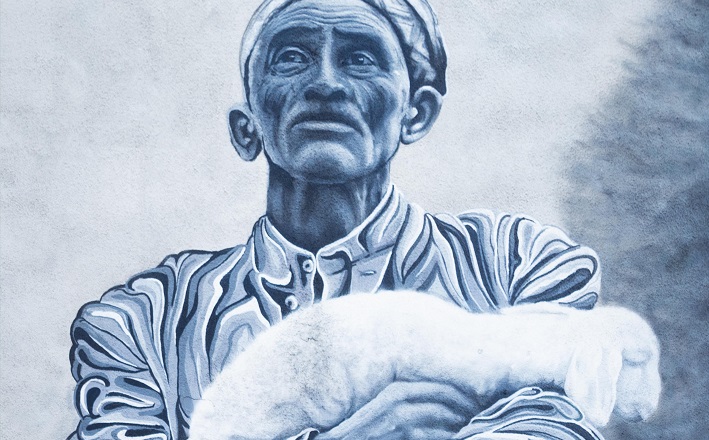Commentary on Revelation 7:9-17
Prior to the opening of the dreaded seventh seal, Revelation delivers an amazing and hope-filled surprise: a “salvation interlude,” assuring God’s people they are protected.1
Just when we are expecting even more destruction with the opening of the seventh seal there is a delay. The scene shifts. Four angels stand at the four corners of the earth, holding back destructive winds. Their mission is to hold back the judgments until God’s people can be “sealed” (7:1-8).
Even in the most difficult sections of Revelation, God’s judgment is not unrelenting. A similar “salvation interlude” will interrupt the trumpet sequence, between the sixth and seventh trumpet (Revelation 10-11). The interludes function rhetorically to shape the identity of God’s people as “protected, separated, praising, persecuted, and vindicated,” as Peter Perry describes2 — preparing the community to persevere in its witness even in the midst of the hardships that lie ahead.
Today’s text — a favorite for funerals and All Saints Day — portrays the multitude of God’s people standing before the throne of God, “sheltered” by God’s tabernacling presence. The scene divides into two sections, a heavenly vision (Revelation 7:9-12) and its interpretation (7:13-17). Worship and praise are central to both sections. Since those who belong to the lamb are said to be a multitude “that no one could count” (7:9), any literalistic fixation on the number 144,000 in the earlier vision of twelve tribes (7:4) is thus undermined.
“From every nation, from all tribes and peoples and tongues” (7:9; see also 5:9) underscores the multi-ethnic character of the people of God. Cuban scholar Justo Gonzales compares the multicultural perspective of Revelation to mestizo literature, addressed to people of a mixed cultural heritage.
John may have been a recent refugee to Asia Minor from Palestine following the trauma of the Roman-Jewish War. For Gonzales, Johns’ dual identity as a Jew writing to Greek-speaking people in Asia Minor, in a land and language not his own, places him in a situation similar to people with hybrid identities today: “The mestizo is at home in two places, and is not quite at home in either.”3
The white-robed multitude sings songs and waves Palm branches. Their daring hymns voice counter-imperial claims, saying that salvation, blessing, glory and power belong to God alone. Palm branches in the hands of these worshipers are a possible allusion to the Feast of Tabernacles, an Exodus link (Leviticus 23:40-43). For Revelation, a dramatic new Exodus is being undertaken not in Egypt but in the heart of the Roman Empire. Led by the Shepherd-Lamb Jesus, God calls Christians to “come out” of Rome (Revelation 18:4), in the same way that the Israelites came out of Egypt.
After the vision, one of the elders gives its interpretation, a typical apocalyptic question-and-answer format. The question-and-answer section also helps cement John’s identity with his community, since he — like them– has to ask for interpretive help. People who belong to the lamb’s multitude are those who have come out of the great thlipsis (“tribulation”). This word, which recurs throughout Revelation, is key to understanding the situation that John shares with his communities (1:9). The “tribulation” (thlipsis) of Revelation’s audience was not state-sponsored persecution but rather the social, economic, and religious marginalization of those who refused to participate in Roman imperial system.
In an incongruous combination of colors, the multicultural multitude washes their robes in the Lamb’s blood to make them white. This may be a reference to the washing away of sin commanded in Isaiah 1:16-18 (“though your sins are like scarlet, they shall be like snow…”).
Those who come through the tribulation now “serve” God. Like a shepherd, God tenderly cares for the people — a wonderful image for Good Shepherd Sunday. The verb “shelter” (skenosei) invokes tabernacle imagery, the sense of God’s radiant presence or dwelling as a canopy or tent over us (see Ezekiel 37:27). The longest of Revelation’s hundreds of Old Testament allusions draws from Isaiah 49:10, the call to return home from exile: God’s people will not hunger or thirst on their journey through the wilderness, nor will any scorching wind or sun touch them (Revelation 7:16, a contrast to the sun’s scorching of evildoers in Revelation 16:7).
In an amazing combination of imagery, the Lamb Jesus now becomes also the shepherd, tending the flock, leading people to springs of water, and wiping away all their tears (a quote from Isaiah 25:8). Led by their Shepherd-Lamb, God’s redeemed people will come through the tribulation into God’s new Promised Land.
“Who is able to stand?” was the rhetorical question left dangling at the end of the dreaded sixth seal, after the four seals’ deadly horsemen and the fifth seal’s depiction of Rome’s victims under the altar. The interlude of Revelation 7 has given God’s people their answer to that question by depicting their identity as a redeemed community, wearing white robes and singing. By the end of the interlude of Revelation 7 all of us as God’s people can confidently answer: “With God’s help, we are able to stand.”
Notes:
1 Commentary first published on this site on April 21, 2013.
2 Peter Soren Perry, The Rhetoric of Digressions: Revelation 7:1-17 and 10:1-11:13 and Ancient Communication (WUNT, 2. Reihe 268; Tuebingen: Mohr Siebeck, 2009), 217.
3 Justo Gonzales, For the Healing of the Nations: The Book of Revelation in an Age of Cultural Conflict (Maryknoll, NY: Orbis, 1999), 59.


May 12, 2019